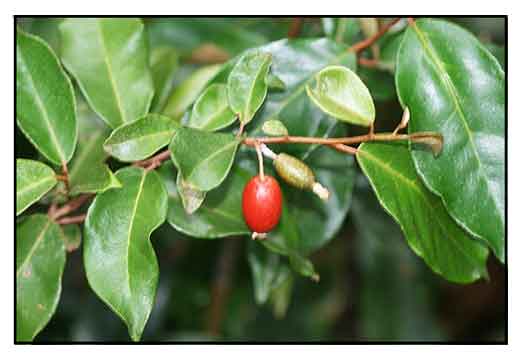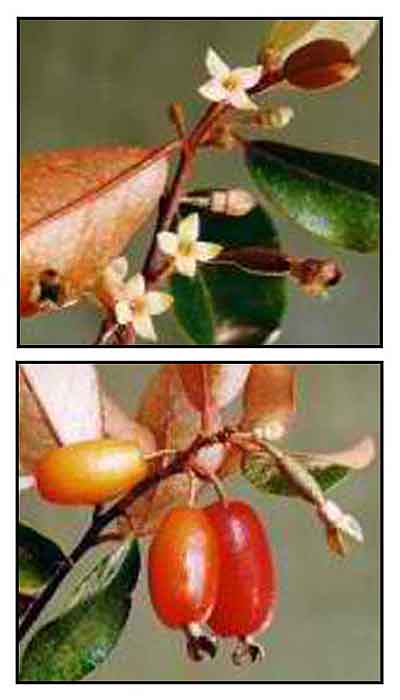
Family • Elaeagnaceae
Lingaro
Elaeagnus triflora var. triflora
MILLA MILLA VINE
| Scientific names | Common names |
| Elaeagnus alingaro Schltdl. | Alingaro (Tag.) |
| Elaeagnus angustifolia Blanco | Alunut (Iv.) |
| Elaeagnus cumingii Schltdl. | Bantap (Sul.) |
| Elaeagnus cumingii subsp. perrottetii Servett. | Banaken (Bon.) |
| Elaeagnus cumingii subsp. philippensis (Perr.) Servett. | Bennaken (Bon.) |
| Elaeagnus ferruginea Rich. | Kopapei (Ig.) |
| Elaeagnus ferruginea subsp. sumatrana Servett. | Kopapey (Ig.) |
| Elaeagnus ferruginea var. atrovirens Servett. | Lagot (Buk.) |
| Elaeagnus ferruginea var. richardia Servett. | Lingaro (Tag.) |
| Elaeagnus latifolia var. triflora (Roxb.) Schltdl. | Malaimus (P. Bis.) |
| Elaeagnus perrottetii Schlecht . | Padias (Ig.) |
| Elaeagnus philippensis Perr. | Millaa millaa vine (Eng.) |
| Elaeagnus rigida Blume | Milla milla vine (Engl.) |
| Elaeagnus rostrata Servett. | Wild olive (Engl.) |
| Elaeagnus triflora subsp. obsoleta Servett. | |
| Elaeagnus triflora subsp. polymorpha Servett. | |
| Elaeagnus triflora subsp. rigida Servett. | |
| Elaeagnus triflora subsp. tetragonnia Servett. | |
| Elaeagnus triflora var. brevipes Servett. | |
| Elaeagnus triflora var. longipes Servett. | |
| Elaeagnus zollingeri Servett. | |
| Elaeagnus triflora var. triflora is an accepted name. KEW: plants of the World Online | |
| Plants of the World Online lists Elaeagnus triflora Roxb. as an accepted species and list one homotypic synonym: Elaeagnus latifolia var. triflora (Roxb.) Schltdl. and 2 accepted infraspecifics: E. triflora var. brevilimbatus E.'t Hart and Elaeagnus triflora var. triflora. | |
| Other vernacular names |
| CHINESE: Guo ma na. |
| FRENCH: Goumi du japon. |
| INDONESIA: Areuj dudureman, Hail-hail, Kelin, Kelintju. |
| SPANISH: Alingaro. |
| THAI: Salot thao, Malot, Somlot. |
| VIETNAMESE: Day nhot. |
Updated January 2023 /June 2018 / August 2016
![]()
 |
PHOTOS / ILLUSTRATIONS |
| IMAGE SOURCE: Photograph: Elaeagnus triflora / © Photographs and text: Arthur Chapman / CC BY-NC-SA / Non-commercial use / click on image to go to source page / iNaturalistGT |
| OTHER IMAGE SOURCE: Photographs(2): Elaeagnus triflora--Milla milla vine fruit / © Flowering Now in Noosa / cnon-commercial use / click on image to go to source page / Flowering Now in Noosa |
Additional
Sources and Suggested Readings |
• |
DOI: It is not uncommon for links on studies/sources to change. Copying and pasting the information on the search window or using the DOI (if available) will often redirect to the new link page. (Citing and Using a (DOI) Digital Object Identifier) |
| List of Understudied Philippine Medicinal Plants |
• |
 |
• |



